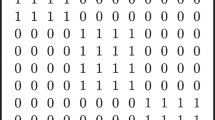Abstract
We introduce a new class of set covering heuristics, based on clustering techniques. In its simplest form, a heuristic in this class may be described as follows: firstly, partition the column set into clusters formed by columns that are close to each other (e.g. in the Hamming distance sense). Then select a “best” (e.g. a cheapest) column in each cluster; if the selected columns form a coverC, then extract fromC a prime cover and stop; else, modify the partition (e.g. by increasing the number of clusters) and repeat. We describe two implementations of this general algorithmic strategy, relying on the Single Linkage and the Leader clustering algorithm, respectively. Numerical experiments performed on 72 randomly generated test problems with 200 or 400 rows and 1000 columns indicate that the above two heuristics often yield cheaper covers than other well-known (greedy-type) heuristics when the cost-range is not too narrow.
Similar content being viewed by others
References
M.R. Anderberg,Cluster Analysis for Applications (Academic Press, New York, 1973).
E. Balas and M.W. Padberg, On the set covering problem II, Oper. Res. 23(1975)74–90.
E. Balas and A. Ho, Set covering algorithms using cutting planes, heuristics, and subgradient optimization: a computational study, Math. Progr. Studies 12(1980)36–60.
E. Balas, A class of location, distribution, and scheduling problems: modeling and solution methods, Rev. Belge de Statistique, d'Informatique et de Recherche Opérationnelle 22(1982)36–57.
R. Bar-Yehuda and S. Even, A linear-time approximation algorithm for the weighted vertex-cover problem, J. Algor. 2(1981)198–203.
V. Chvátal, A greedy heuristic for the set covering problems, Math. Oper. Res. 4(1979)223–235.
M. Delattre and P. Hansen, Bicriterion cluster analysis, IEEE Trans. PAMI 2(1980)277–291.
T.A. Feo and M.G.C. Resende, A probabilistic heuristic for a computationally difficult set covering problem, Oper. Res. Lett. 8(1989)67–71.
M.L. Fisher and P. Kedia, Optimal solution of set covering problems using dual heuristics, Technical Report, Department of Decision Sciences, The Wharton School, University of Pennsylvania, Philadelphia (1986).
A.D. Gordon,Classification (Chapman and Hall, London, 1981).
J.C. Gower and G.J.S. Ross, Minimum spanning trees and Single Linkage cluster analysis, Appl. Statist. 18(1969)54–64.
J. Hartigan,Clustering Algorithms (Wiley, New York, 1975).
D.S. Hochbaum, Approximation algorithms for the set covering and vertex-cover problems, SIAM J. Comput. 11(1982)555–556.
E.L. Lawler,Combinatorial Optimization: Networks and Matroids (Holt, Reinhart, and Winston, New York, 1976).
L. Lovász and M.D. Plummer,Matching Theory, Annals of Discrete Mathematics vol. 29 (North-Holland, Amsterdam, 1986).
N. Maculan, The Steiner problem in graphs, Ann. Discr. Math. 31(1987)185–211.
J.M. Mulvey and H.P. Crowder, Cluster analysis: an application of Lagrangian relaxation, Manag. Sci. 25(1971)329–340.
S. Sahni and T. Gonzalez, P-complete approximation problems, J. ACM 23(1976)556–565.
C. Vercellis, A probabilistic analysis of the set covering problem, Ann. Oper. Res. 1(1984)255–271.
Author information
Authors and Affiliations
Additional information
The present work is based on R.K. Kwatera's dissertation, written under the supervision of B. Simeone. A preliminary version was presented at EURO VIII, Paris, July 1988.
Rights and permissions
About this article
Cite this article
Kwatera, R.K., Simeone, B. Clustering heuristics for set covering. Ann Oper Res 43, 295–308 (1993). https://doi.org/10.1007/BF02025300
Issue Date:
DOI: https://doi.org/10.1007/BF02025300




